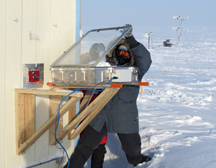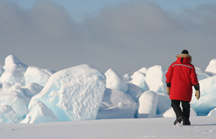Sunlit snow triggers atmospheric cleaning, ozone depletion in the Arctic
April 15, 2013
 |
|
NSF
Postdoctoral Fellow in Polar Regions Research Kerri Pratt conducts a snow
chamber experiment at minus 44 degree wind chill near Barrow, Alaska. (Purdue
University photo/courtesy of Paul Shepson)
|
WEST LAFAYETTE, Ind. - A Purdue University-led team of researchers discovered sunlit snow to be the major source of atmospheric bromine in the Arctic, the key to unique chemical reactions that purge pollutants and destroy ozone.
The team's findings suggest the rapidly changing Arctic climate - where surface temperatures are rising three times faster than the global average - could dramatically change its atmospheric chemistry, said Paul Shepson, the professor of chemistry who led the team.
"We are racing to understand exactly what happens in the Arctic and how it affects the planet because it is a delicate balance when it comes to an atmosphere that is hospitable to human life," said Shepson, who also is a founding member of the Purdue Climate Change Research Center. "The composition of the atmosphere determines air temperatures, weather patterns and is responsible for chemical reactions that clean the air of pollutants."
Changes in the Arctic are felt throughout the rest of the planet through weather changes, like the longer and colder winter the Midwest experienced this past year due to Arctic weather systems, he said.
"Although changes in the Arctic seem far removed from our daily lives, more than the polar bears will be affected by the rising temperatures and melting sea ice," he said. "We need to know what is happening there now in order to understand what we may face in the future."
 |
|
Purdue
graduate student Kyle Custard explores the snow-covered sea ice near Barrow,
Alaska. (Purdue University photo/courtesy of Kerri Pratt) |
Ozone in the lower atmosphere is different from the stratospheric ozone involved in the planet's protective ozone layer. This lower atmosphere ozone is a greenhouse gas that is toxic to humans and plants, but it also is an essential cleaning agent of the atmosphere. Interactions between sunlight, ozone and water vapor create an "oxidizing agent" that scrubs the atmosphere of most pollutants human activity releases into it, Shepson said.
Temperatures at the poles are too cold for the existence of much water vapor, and in the Arctic this cleaning process appears instead to rely on reactions on frozen surfaces involving bromine, a halogen gas derived from sea salt.
This gaseous bromine reacts with and destroys atmospheric ozone. This aspect of the bromine chemistry works so efficiently in the Arctic that ozone is often entirely depleted from the atmosphere above sea ice in the spring, he said.
"This is just a part of atmospheric ozone chemistry that we don't understand very well, and this unique Arctic chemistry teaches us about the potential role of bromine in other parts of the planet," he said. "Bromine chemistry mediates the amount of ozone, but it is dependent on snow and sea ice, which means climate change may have important feedbacks with ozone chemistry."
While it was known that there is more atmospheric bromine in polar regions, the specific source of the natural gaseous bromine has remained in question for several decades, said Kerri Pratt, a National Science Foundation postdoctoral fellow in polar regions research at Purdue who participated in the research.
"We thought that the fastest and best way to understand what is happening in the Arctic was to go there and do the experiments right where the chemistry is happening," Pratt said.
She and Purdue graduate student Kyle Custard performed the experiments in minus 50 to minus 30 degree Fahrenheit wind chills near Barrow, Alaska. The team examined first-year sea ice, salty icicles and snow and found that the source of the bromine gas was the top surface snow above both sea ice and tundra.
"Sea ice had been thought to be the source of the gaseous bromine," she said. "We had an 'of course!' moment when we realized it was the snow on top of the sea ice. The snow is what is in direct contact with the atmosphere. Sea ice is critical to the process, though. Without it, the snow would fall into the ocean, and this chemistry wouldn't take place. This is among the reasons why the loss of sea ice in the Arctic will directly impact atmospheric chemistry."
A paper detailing the results of the National Science Foundation and NASA-funded work is published online at Nature Geoscience.
The team also discovered that sunlight triggered the release of bromine gas from the snow and the presence of ozone increased the production of bromine gas.
"Salts from the ocean and acids from a layer of smog called Arctic haze meet on the frozen surface of the snow, and this unique chemistry occurs," Pratt said. "It is the interface of the snow and atmosphere that is the key."
A series of chemical reactions that quickly multiplies the amount of bromine gas present, called the "bromine explosion," is known to occur in the atmosphere. The team suggests this also occurs in the spaces between the snow crystals and wind then releases the bromine gas up into the air above the snow.
The team performed 10 experiments with snow and ice samples contained in a "snow chamber," a box constructed of aluminum with a special coating to prevent surface reactions and a clear acrylic top. Clean air with and without ozone was allowed to flow through the chamber and experiments were performed in darkness and in natural sunlight.
The team also measured the levels of bromine monoxide, a compound formed from the reaction of bromine atoms with ozone, through flights of the Purdue Airborne Laboratory for Atmospheric Research. Shepson is the pilot of this specially equipped aircraft, which he and air operations technical specialist Brian Stirm flew from Indiana to Barrow for these experiments. They found the compound was most prevalent over snow-covered first-year sea ice and tundra, consistent with their snow chamber experiments.
The experiments were performed from March to April 2012 and were part of NASA's Bromine, Ozone and Mercury Experiment, or BROMEX. The goal of the study is to understand the implications of Arctic sea ice reduction on tropospheric chemistry.
In addition to Shepson, Pratt, Custard and Stirm, the research team included instrumentation specialist Mark Carlsen from Purdue; Thomas Douglas from the U.S. Army Cold Regions Research and Engineering Laboratory at Fort Wainwright, Alaska; Denis Pöhler, Stephan General, Johannes Zielcke and Ulrich Platt from the University of Heidelberg, Germany; William Simpson from the University of Alaska Fairbanks; and David Tanner and L. Gregory Huey from the Georgia Institute of Technology.
Shepson's group next plans to perform laboratory studies to test the proposed reaction mechanisms and to return to Barrow to perform more snow chamber experiments. In addition, Shepson is co-leading a team using ice-tethered buoys to measure carbon dioxide, ozone and bromine monoxide across the Arctic Ocean, and Pratt is working with scientists from the University of Washington to examine the chemistry of snow from across the Arctic Ocean.
"In the Arctic, climate change is happening at an accelerated pace," Pratt said. "A big question is what will happen to atmospheric composition in the Arctic as the temperatures rise and snow and ice decline even further."
Writer: Elizabeth Gardner, 765-494-2081, ekgardner@purdue.edu
Sources: Paul Shepson, 765-494-7441, pshepson@purdue.edu
Kerri Pratt, kapratt@purdue.edu
Related websites:
Shepson group atmosphere/snow surface interactions research
ABSTRACT
Photochemical Production of Molecular Bromine in Arctic Surface Snowpacks
Kerri A. Pratt, Kyle D. Custard, Paul B. Shepson, Thomas A. Douglas, Denis Pohler, Stephan General, Johannes Zielcke, William R. Simpson, Ulrich Platt, David J. Tanner, L. Gregory Huey, Mark Carlsen and Brian H. Stirm
Following the springtime polar sunrise, ozone concentrations in the lower troposphere episodically decline to near-zero levels. These ozone-depletion events are initiated by an increase in reactive bromine levels in the atmosphere. Under these conditions, the oxidative capacity of the Arctic troposphere is altered, leading to the removal of numerous transported trace gas pollutants, including mercury. However, the sources and mechanisms leading to increased atmospheric reactive bromine levels have remained uncertain, limiting simulations of Arctic atmospheric chemistry with the rapidly transforming sea-ice landscape. Here, we examine the potential for molecular bromine production in various samples of saline snow and sea ice, in the presence and absence of sunlight and ozone, in an outdoor snow chamber in Alaska. Molecular bromine was detected only on exposure of surface snow, collected above tundra and first-year sea ice, to sunlight. This suggests that the oxidation of bromide is facilitated by a photochemical mechanism, which was most efficient for more acidic samples characterized by enhanced bromide to chloride ratios. Molecular bromine concentrations increased significantly when the snow was exposed to ozone, consistent with an interstitial air amplification mechanism. Aircraft-based observations confirm that bromine oxide levels were enhanced near the snow surface. We suggest that the photochemical production of molecular bromine in surface snow serves as a major source of reactive bromine, which leads to the episodic depletion of tropospheric ozone in the Arctic springtime.

